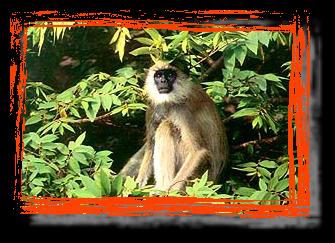
|
Monkey
The gray langur, with the
midnight-black face (shown
here) and the macaque, or
the red monkey are seen widespread in Sri Lanka's jungle areas and sometimes
even in the small villages.
The larger ofthe two species,
the langur, lives in large
groups among the trees andis usually not aggressive. Groups of these monkeys
are a common sight at some of the Buddhist temples in the dry region, and
most often seen begging for ive-aways, or if un-successful, stealing, from
the unsuspecting visitor.
There are several other
species of monkey in the
Sri Lanka jungles, but they
are confined to the hilly
and mostly inaccessible
areas and for this reason
are not seen by the average
visitor to the island.
|
|
Bird
One of the three bee-eaters
found in the island
(one a migrant) this resident
bird is widly distributed
both in the wet and drt
zones. It feeds on insects, the favourite being the dragon files which
it catches on the
wing performing aerial acrobatics
that will make the
finest air ace blush. This
super specimen was seen at Diganwala in the Yala National Park.
|
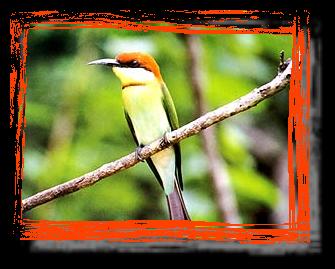
|
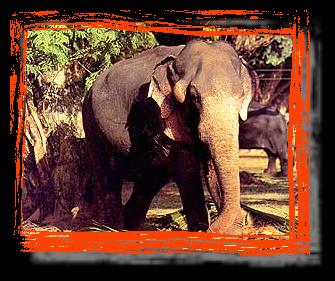
|
Elephant
Elephant is the "tractor"
of the jungle. It can easily
haul twenty foot sections
of hard-wood from the
middle of the jungle to
the road, generally finds its
own food, and only demands
loyalty and a good
word from it's trainer,
the mahout. For, if the
mahout mis-treats the elephant, there
are mumerous
recorded cases, where the
elephant will take
revenge, and in most cases
fatal to the mahout.
It is estimated that there
are about 2,500 to 3000
elephants in Sri Lanka,
and about 500 of them are
tame, and are used for work.
In rural areas it is
fairly common to see an
elephant on the side of the
road, with a big bundle
of coconut leaves in it's
mouth, coming home for the
night with the mahout
riding on its' back.
|
|
Deer
There are four species
of deer in the plains and jungles
of Sri Lanka. Spotted deer,
barking deer, mouse deer
and the Sambhur (elk).
The
Sambhur is somewhat
darker than the others,
and is the biggest, about five
feet atthe shoulders, and
perhaps the most handsome.
The "spotted deer" shown
here is by far, the most
common,and can be seen in
large herds in some
of the nationalparks and
most of the open plains,
specially inthe northern
dry sector.
|
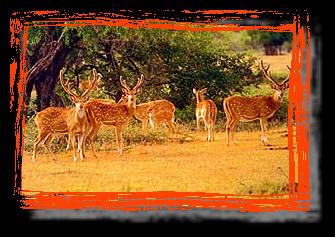
|
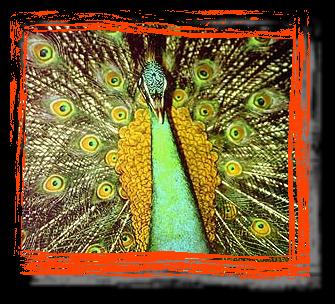
|
Peacock
The peacock, largest of the
pheasants, is native to
Sri Lanka and India. It
is often the male of the
species that is shown in
photographs, showing the
beautiful plumage. Hence
the simile "proud as a
peacock". The female (pea
hen) lacks the beautiful ornamental feathers or the bright coloring.
Although native to Sri Lanka,
the peacock population
has gone down considerably,
for, at one time it was considered a delicacy and peafowl were hunted
down indiscriminately. Pea
fowl are tamed quite
readily, and sometimes can
be seen in the lawns
of some of the hotels, and
bigger private residences.
For Hindus in Sri Lanka,
peacock holds a special
place too, for Skanda
the
God of Katharagamasits
with his wives astride a
peacock. Lord Vishnu, one
of the major Gods, also
is often shown with a
peacock in the background.
|
|
Heron
The common heron, that is
seen everywhere in the
island, apart from being
a sight to behold when in
flight in a large group,
also serves as a pest controller
in the rice fields. It's
primary food source, the crabs
that live in the fields,
could raise havoc in the terraced
rice paddies, if not controlled.
An occasional fish or a
baby snake that may wonder
into it's path is sure to be made into heron poop too!.
|
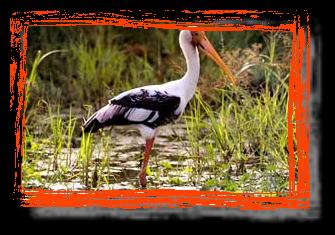
|
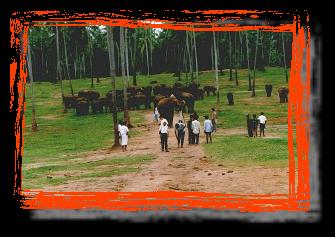
|
Pinnewala Elephant Orphanage,
deep in the tropical
hill country, the motherless
calves are raised by
dedicated human foster parents
who ply them with
bottled milk five times
a day, and an occasional swig of beer, in an effort to help preserve Asia's
dwindling wild-elephant population.
The orphans arrive here from
across the country,
rescued from remote areas
where they have lost
their mothers to accidents,
to poachers, and most
often to land mines left
by the warring factions in the northern part of the country.
Click on the following links
to read more about Elephants :
Wild
Elephants
Homeless
Elephants ...
Elephant
Orphanage ... |
|
